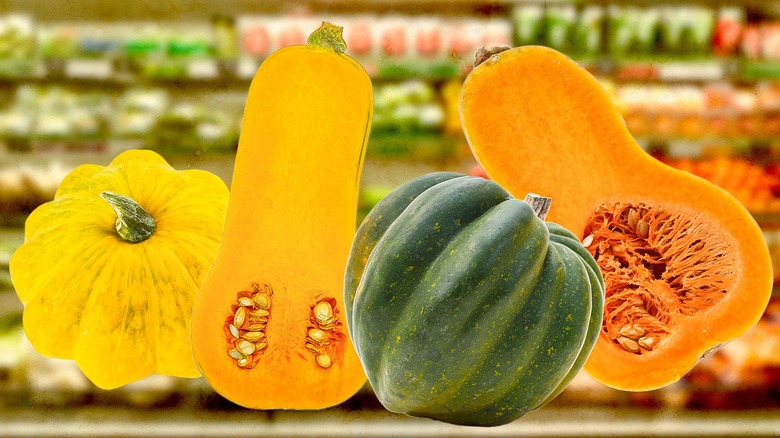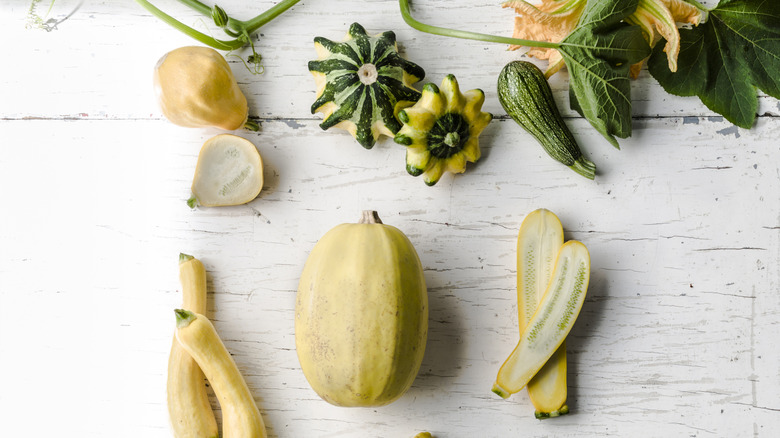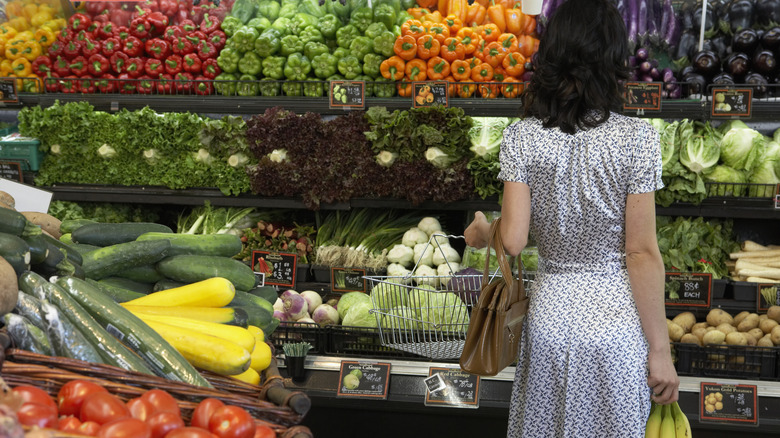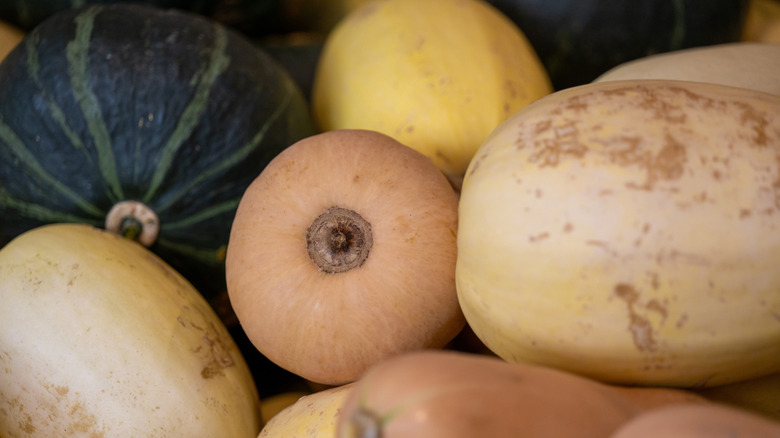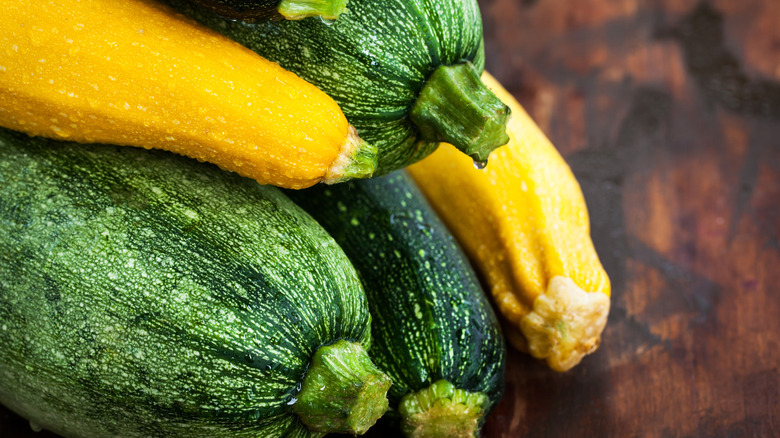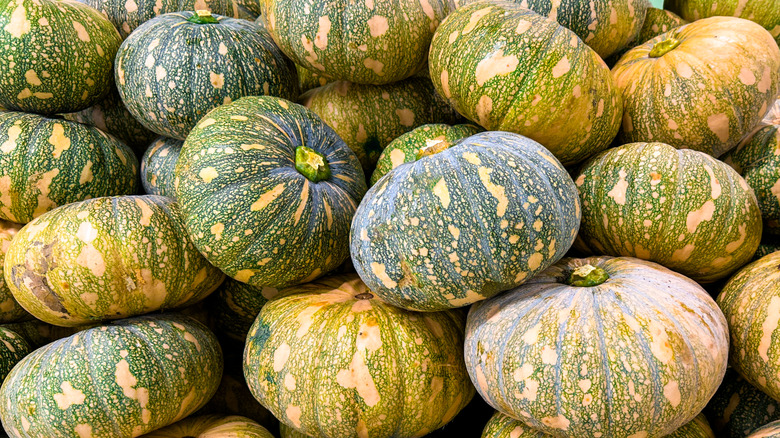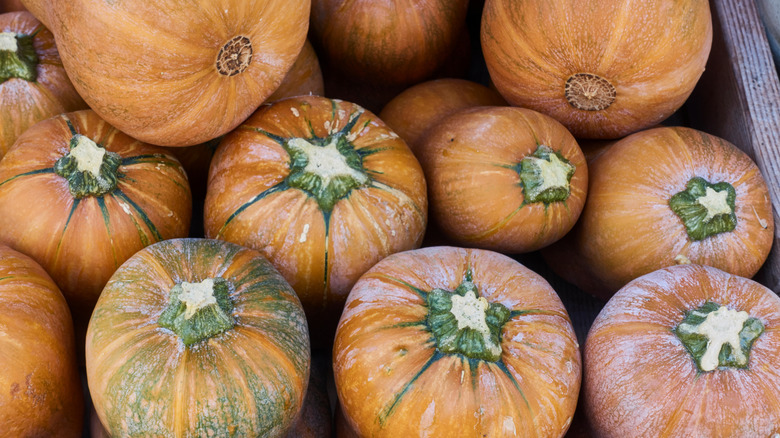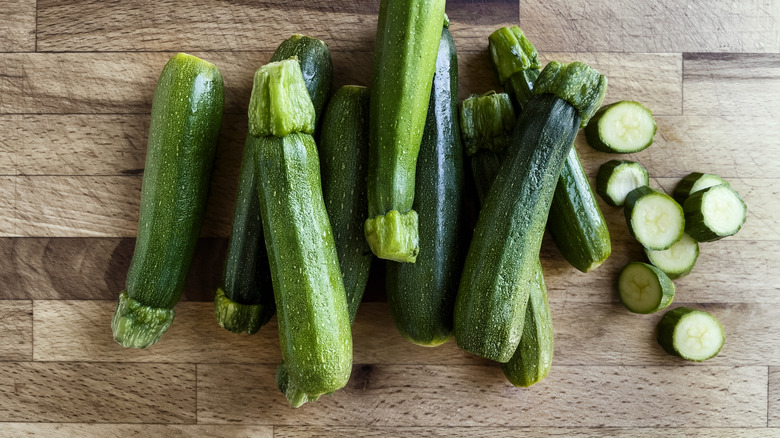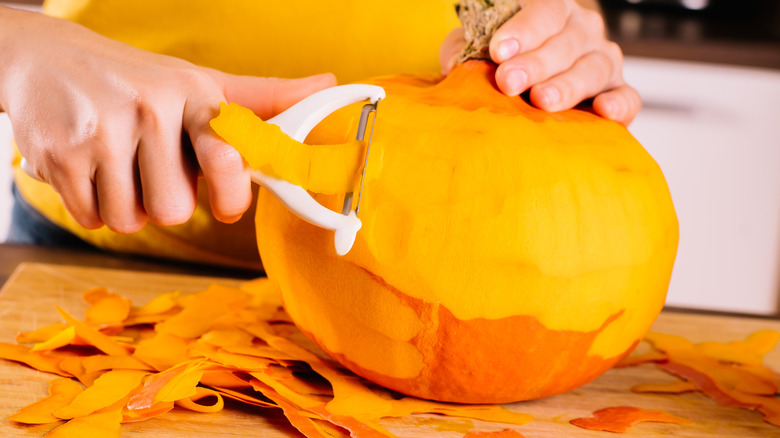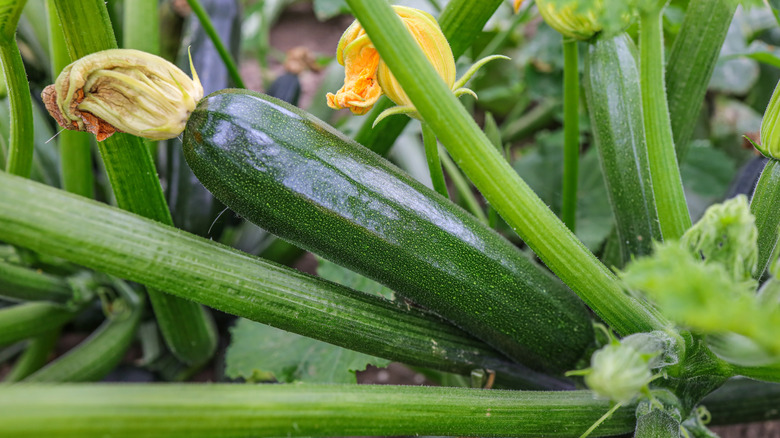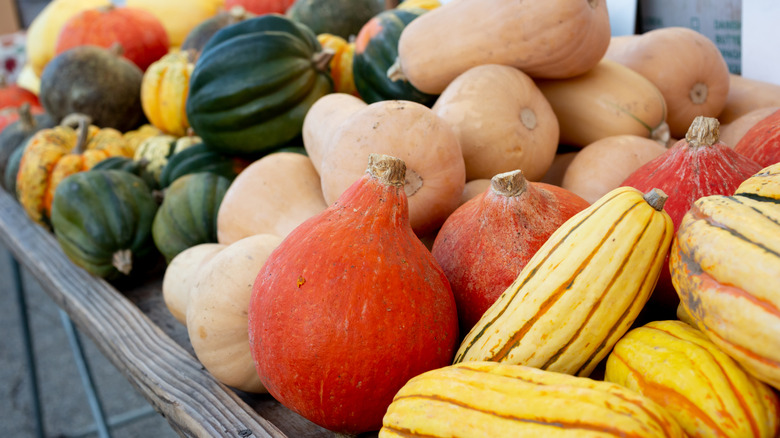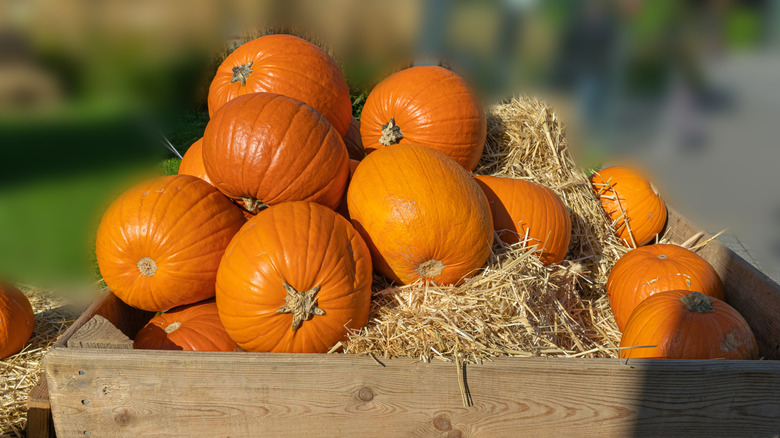11 Rules Of Thumb For Buying Squash At The Store
Native Americans cultivated squash as a staple food crop thousands of years ago. Since then, it has gained popularity around the world and has become a staple in various cuisines. Although often categorized and referred to as a vegetable, all varieties of squash are actually fruit. There are endless varieties of squash with an incredible range of colors, shapes, sizes, and textures. When your recipe calls for "squash," it's important to know exactly what variety you need, and even more so how to select a healthy, ripe squash. That's why we've developed some rules of thumb for buying squash at the store.
As a plant-based chef and recipe designer with a Plant-Based Nutrition Certification from Cornell, I am hyper-aware of how your produce selection recipe can greatly alter a recipe. The outcome of your dish is determined from the moment you enter the grocery store. Quality produce is the key to incredible culinary creations, but what gives produce quality? There are several important factors that go into making a selection. So, why not give your dish the best chance you can at invoking salivation and awe?
Understanding summer vs. winter squash
There are endless varieties of squash out there, but at the most basic level, they are categorized into two sections: Winter squash and summer squash. Summer squash has fewer varieties, and — you guessed it — it is grown in the warmer months. Winter squash typically has tougher skin and denser, starchier flesh, and it gets harvested during the chilly months. These popular types of squash couldn't be more different. If you're having trouble telling the difference, check to see if the skin is rubbery, thin, and malleable. If that's the case, then you are likely dealing with summer squash. If you knock against the squash and it makes a sound, then it's likely winter squash.
The varieties of summer squash are typically interchangeable in a recipe. However, you do not want to substitute summer squash for winter squash or winter squash for summer squash. The two types couldn't be more different when it comes to flavor, texture, and preparation requirements. You can eat summer squash cooked or raw, and the skin and seeds are safe to consume. While you can technically eat winter squash raw, doing so is rare because the raw squash is tough, woody, and quite bitter. The skin is tough, as well, but can be eaten if cooked (although, with the exception of a few varieties, it typically isn't). The seeds are scooped out before the cooking process, and if they are eaten, they're roasted and seasoned separately from the flesh.
Know where to look
So, you've decided to head to the store to buy some squash. Where should you start searching? The produce department is your best bet, although come fall-time, you may find winter squash on display in the front of the store. You can typically find squash in two sections: The refrigerated produce section and the unrefrigerated produce section.
Even though summer squash — and all squash, for that matter — is a fruit, you won't find it with the apples and lemons. People tend to recognize the fruit as a vegetable, so that's where you should start your search. Typically, summer squash is located near refrigerated vegetables, such as broccoli, artichokes, green beans, bell peppers, and eggplants. There's a small chance that a small market with local produce may not refrigerate its summer squash. You can ask an employee if there is any confusion.
Winter squash will likely be proudly displayed at the front and center of the produce section in freestanding shelving. After harvest, it lasts quite a while and doesn't require refrigeration. It's also often used for decor, so stores like to take advantage of its beauty. Off-season, you may find winter squash in the refrigerated produce sections because there is less turnover during this time of year and it may have been shipped in from a greater distance.
Know your basic varieties of winter squash
Did you know that pumpkins are a type of squash? And, pumpkins themselves have many varieties. This is one of the most well-known types of winter squash, and you'll frequently find it in pie. However, there are several other popular varieties of fall and winter squash. Butternut squash is known for its sweet, buttery flesh. It often appears in pasta or rice recipes and is delicious when roasted. Acorn squash is typically the size of a softball and looks like a large green acorn with ridges. Its flesh is bright orange, and although it's not as sweet as butternut, it's quite starchy and delicious. Acorn squash also comes in a white variety that can make for a satisfying mashed potato substitute for those who love mashed potatoes.
Delicata is a beautiful and small variety with yellow, orange, and green stripes. It is roughly the shape of a large, thick cucumber and is often cut lengthwise and then sliced into small "U" shapes before being roasted. Delicata is uber-sweet and popular in grain bowls and salads. Spaghetti squash is one of the more uniquely textured fruits, as its flesh forms into long, thin strands once it's cooked. This resembles spaghetti, which gives the squash its name. Spaghetti squash is often served as a pasta substitute, and you can even twirl it using a fork.
Know your basic varieties of summer squash
There are fewer varieties of summer squash, and they are all fairly interchangeable. Zucchini is perhaps the most popular. In fact, it's hard to go to a potluck or restaurant during zucchini harvest season and avoid it. It's green and looks like a large cucumber with a stem. Its flesh is soft and white, and its skin is thin and rubbery. Zucchini is sweet when eaten raw or cooked, although any bitterness from the raw vegetable escapes when it's heated. In the last decade, many cooks have embraced spiralized zucchini. We call these "zoodles," and they can be eaten (whether they're cooked or uncooked) just like spaghetti and loaded with sauces and seasonings.
Yellow squash is essentially the yellow version of zucchini. It tends to have a more irregular shape and is more bulbous on one end. It's a bit milder than zucchini and has more bitterness when it's raw. Pattypan squash is more unique looking than the other two varieties. It's shaped like a flying saucer with a lumpy rim. It comes in yellow, green, and white, but its flesh is always white. Use pattypan when you're looking for firmer, moe-structured chunks, instead of slices. It can also be quite aesthetic when you cut it into cross sections.
The lesser-known varieties may surprise you
Some winter squash look like they are growing appendages and bursting with lumps, but not all delicious foods come in beautiful packages. Some of the lesser-known varieties with more unique exteriors are actually some of the most delicious. Hubbard squash is starchy, dense, sweet, and flavorful. In fact, it's my favorite winter squash to experiment with because it's buttery and delicious, and its flesh is bright and beautiful. Hubbard squash has thick skin, so be sure to use a freshly sharpened knife when you work with it. Cut it in half, remove the seeds, season the flesh with spices and olive oil, and then place the halves, cut-side down, in a baking dish to roast them.
Reach for Koginut squash if you're looking for a unique squash variety to try this fall. It's similar to butternut squash but is more custardy, sweet, and creamy. It has an earthy undertone to balance the sugars and has an impeccably consistent texture. Kabocha squash is another flavorful variety that's bursting with sweet undertones. It's a fairly hallow squash, so if you're looking to add it to soup or make a mash, get more than you think you might need. If you're feeling experimental, choose the most unique-looking winter squash at the store, bring it home, and look up some recipes to expand your horizons — this is one of the best ways to refine your culinary skills.
Know which varieties are the sweetest
Come Thanksgiving time, everyone is drooling for a bite of pumpkin pie. If there is something that winter squash knows how to do right, it's dessert. Although it's usually not thought of in a sweet capacity beyond pumpkin pie, you can use winter squash in endless dessert recipes, and it can contribute to a sweet and salty combination in savory dishes.
The best types of winter squash for pie go beyond sugar pumpkins. Next time, give buttercup squash or Hubbard a try. Both are dense and buttery like pumpkins and also contain all of those natural sugars that sweeten up when they're cooked. You may even enjoy it more than a classic pumpkin pie, and your guests won't be able to guess your secret ingredient. Another, sweeter alternative to butternut squash is honeypatch squash.
Try using these sweet varieties in custard, pie, ice cream, smoothies, and pastries. Beyond dessert, dice and roast th sweet squash with a little salt, pepper, and maple syrup to help bring out the sugars. Looking for a little more flavor? Add thyme, garlic powder, and even a little cayenne to help bring the squash alive. Alternatively, opt for pumpkin spice seasoning to lean into those warming, spicy comfort flavors. Although, if you're hoping to highlight the true and pure flavors of the squash, consider seasoning it with just a little coconut oil and salt.
Size does matter
When you're selecting produce, it may seem like you should reach for the larger sizes, especially if you're paying per item instead of by weight. More bang for your buck, right? It's not that simple. While you might get more quantity, the quality doesn't always compare. Smaller produce typically has a bolder flavor and preferable texture, which is why we typically avoid oversized carrots and zucchini. While you might win a blue ribbon for a massive squash or zucchini at a harvest festival, nobody is begging you to make a meal with it.
If you've already brought home a massive zucchini, it will work just fine. The skin may be a little tougher and it will likely be more watery and a little spongy on the inside, but it won't ruin the recipe. If you're relying on zucchini's magical flavor notes, swing back through the grocery store for some smaller produce and save the big one for zucchini bread. But, what if your recipe calls for one large zucchini? Opt for two small zucchini instead. Simply weigh a larger one on a grocery store scale and then grab the equivalent weight in smaller zucchini.
The same goes for winter squash. You should consider weight before buying acorn squash, pumpkins, Hubbard, spaghetti, and any other squash. Only opt for a bigger squash is if you plan to stuff it. In that case, find a suitable size for single servings.
Some skins you can eat, and some you can't
The skins of summer squash are edible and delicious. Their bright colors help dress up a meal, and they can be consumed raw or cooked. They are thin and rubbery, similar to a nectarine skin. In fact, there is no reason to peel the skin, even if you're making zoodles. Bon appetite!
Winter squash is a little more complicated. Technically, you can eat the skin of all varieties of winter squash. But, that doesn't mean you'll want to. Winter squash typically has a pretty tough and sometimes woody skin. It varies by variety, but most folks remove the skin to avoid this unpleasant texture. You can do this either before or after you cook it. For peeling raw winter squash, use a sharp peeler and press down firmly. You'll want to cut the fruit in half before doing so to have a steady surface to work with and to prevent rolling. Alternatively, you can cook your squash with the skin on and then scoop out the flesh when it's nice and soft.
However, you can enjoy delicata squash with the skin on, as well as honeynut and acorn squash. These have thinner skin than butternut. Any squash with warty skin is often not desirable to consume.
Select fresh summer squash
You're at the grocery store looking for summer squash — how do you know which ones to pick? There is a trick for finding the freshest produce at the grocery store. First, look for a smaller squash for optimal flavor. Second, you'll want to look for squash with even, vibrant coloring and smooth skin. Any wrinkles or bumpy texture could indicate that it's near the end of its shelf life. Summer squash should not have any brown or dark spots, which indicate rotting. Be especially careful when selecting summer squash that has not been refrigerated.
Next, you'll want to give the squash a nice squeeze. It should be firm with rubbery skin and should have as little give as possible. Summer squash will not be rock hard like an apple, but it shouldn't be soft like a peach. Look for something slightly less firm than a cucumber and slightly more firm than an eggplant. Also seek out heavier summer squash. This indicates water density and freshness, while a spongy zucchini might feel lighter in your hands.
Use your hands to select winter squash
Choosing the best winter squash can be a tricky feat. Luckily, there are a few important steps you can take when picking out pumpkins and squash for consumption. Choosing gourds for your doorstep and countertop decor is much easier — just go with the aesthetic you find most appealing. It's all subjective. If you plan on roasting and eating it, be sure to pick it up and examine it fully.
Those rough patches that look like dirt are typically just the spot where the squash was resting on the ground. Unless you plan to eat the skin or serve it in the skin, this should not be a major deterrent. However, any bruises or soft spots could indicate rotting. Next, pick the squash up and give it a good knock. How does it sound? Hollow sounds are best when you pick out pumpkins. That means it's jam-packed with seeds and pulp and it is more ripe than a solid-sounding pumpkin. This goes for most kinds of winter squash.
You should also look for heavy winter squash. This indicates moisture density, meaning that the squash is juicy and ready to consume. Don't worry about looking goofy in the grocery store. Pumpkin knockers and cantaloupe sniffers know exactly what they are doing. You'll look like a pro, and it will be worth the extra effort.
Choose organic and local when possible
We all know that non-GMO, organic, and local produce is "better." But, is it just a fad, or is there science behind the movement? There is. We always spring for organic produce or shop at local farms or farmers' markets, when possible. Although organic is typically more expensive, that isn't always the case for local produce. In fact, you may even be able to find it cheaper since it doesn't have to be transported across the country. The quality difference is also quite noticeable.
According to the USDA, "organic" means that the food has been grown in soil without any restricted substances, which encompasses synthetic fertilizers or pesticides. The label also addresses things like soil quality. Because produce isn't processed, it must be fully organic to receive the label, whereas some multi-ingredient organic food must be made with at least 70% organic ingredients. Overall, you will have fewer pesticides in your food. Genetically modified organisms (GMOs) are also prohibited in organic foods.
Locally grown food tastes better because it's traveled less of a distance, meaning it hasn't spent time riding around in trucks and stored in warehouses. Food that you consume directly after it's picked tastes better (unless it needs to ripen off of the vine) and is more nutrient-dense. These are both important reasons to buy produce locally. It may also have less of an environmental footprint, so you can feel good about helping the planet, too.
